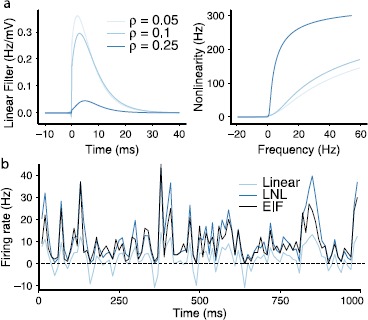Fig. 3.

(a) The linear filter and static nonlinearity F computed for inputs that yield several values of the spike correlation coefficient ρ. The filter receives a noise amplitude of . The static nonlinearity receives a noise amplitude of σ. (b) The static nonlinearity applied to the linear estimate of the firing rate, for , , plotted over a randomly chosen 1000 ms time interval. The nonlinearity increases the firing rate magnitude and rectifies negative firing rates. This gives the predicted firing rates shown in blue; comparing with firing rates computed by binning spikes in 10 ms windows from simulations of the EIF model, shown in black, shows that the LNL is a fairly accurate model of the EIF dynamics
